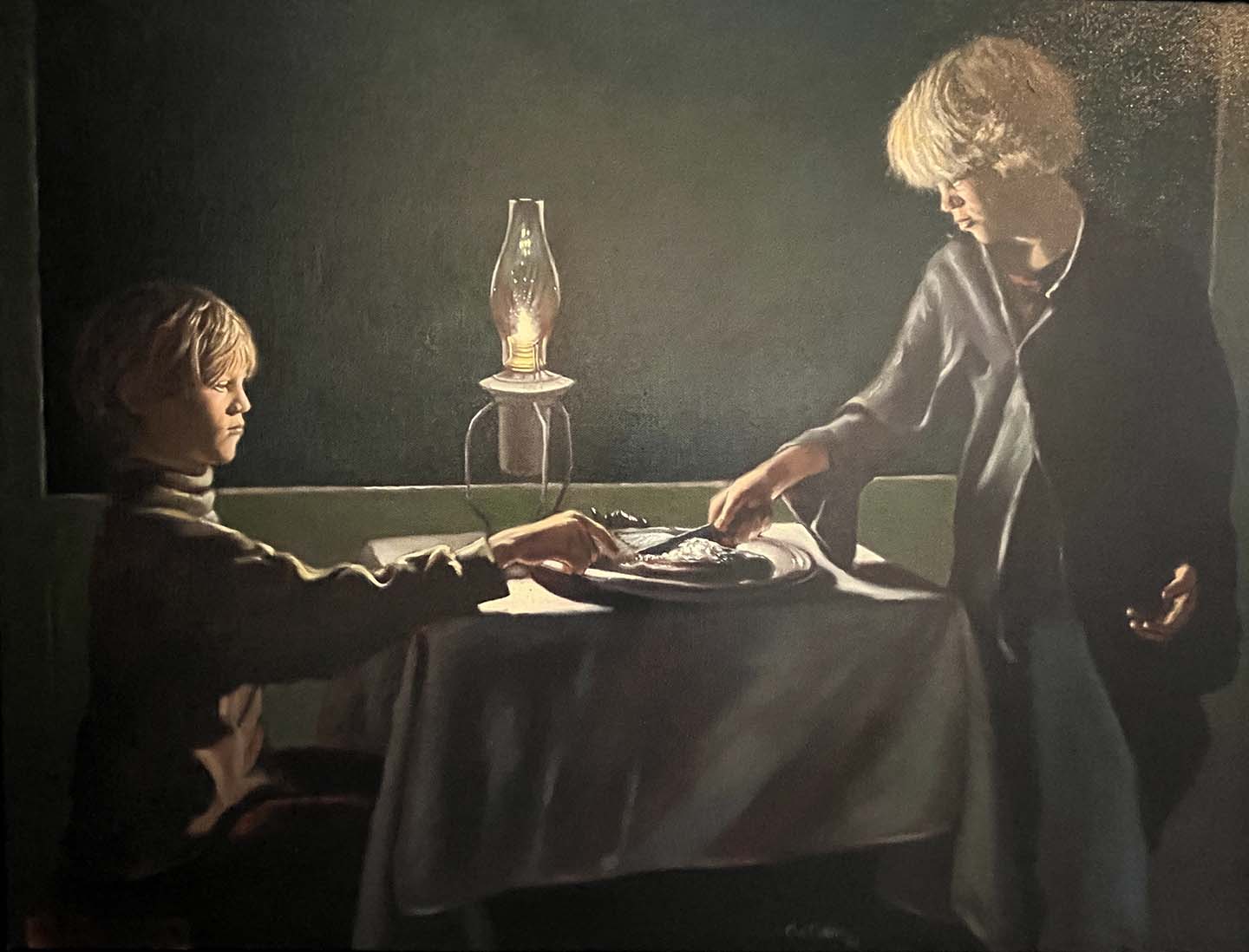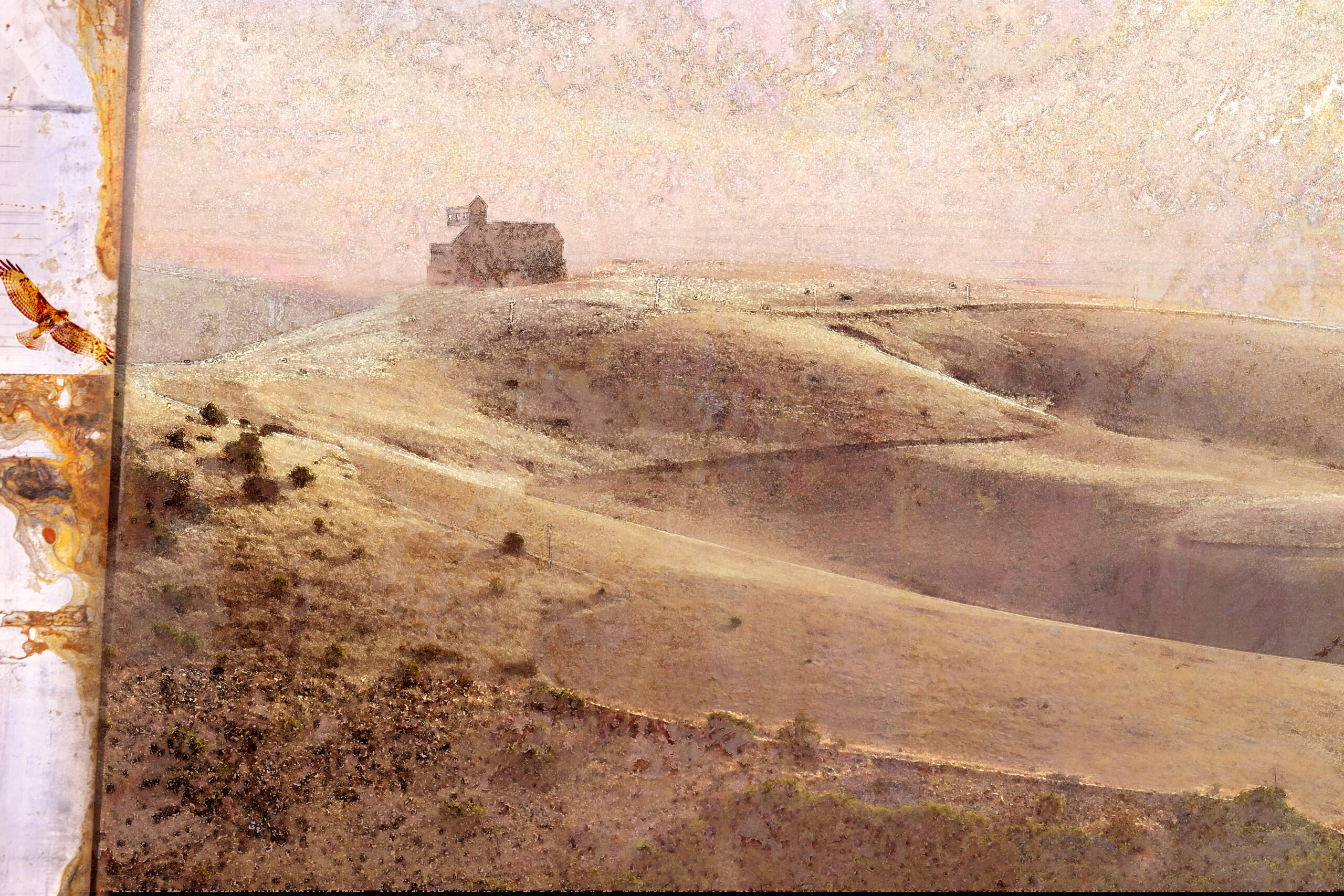In the Eye of the Beholder
· Christopher Pothier at The Columbia Gorge Museum ·
“I cannot help remembering a remark of De Casseres. It was over the wine in Mouquin’s. Said he: “The profoundest instinct in man is to war against the truth; that is, against the Real. He shuns facts from his infancy. His life is a perpetual evasion. Miracle, chimera and to-morrow keep him alive. He lives on fiction and myth. It is the Lie that makes him free. Animals alone are given the privilege of lifting the veil of Isis; men dare not. The animal, awake, has no fictional escape from the Real because he has no imagination. Man, awake, is compelled to seek a perpetual escape into Hope, Belief, Fable, Art, God, Socialism, Immortality, Alcohol, Love. From Medusa-Truth he makes an appeal to Maya-Lie.”
— Jack London, The Mutiny of the Elsinore
When I visited the current exhibition at the Columbia Gorge Museum, a small portrait immediately caught my eye amongst the many large, scenario paintings by Christopher Pothier. Unclear how it ended up joining the selection of art brought together under the title Bring Your Damn Checkbook: Painted Visions. Most of the other work, spanning about a decade in the artist’s career, has distinct narratives critical of how life unfolds – or is manipulated – in our modern times under the pressures of capitalism and political ideologies, down to the commodification of relationships,

Christoper Pothier The Prenup (2022)
invasion of foreign countries,

Christoper Pothier My Vacation Nightmare: Self Portrait as a Political Prisoner (2016)
Riot Police encounters,

Christopher Pothier The Ultimate Cure for Stage Fright (2018)
and (mis)management of pandemic diseases.

Christopher Pothier American Apocalyptic (2020)
The portrait that drew my attention is simply called La Mujer en el Viento, the woman in the wind. No clue why the title is in Spanish, one of several mysteries surrounding the painting. Here is a wind strong enough to blow the entire mane of gorgeous blond hair towards the front of the person, completely covering her face, static electricity perhaps keeping the lighter strands in the air. Yet the slender figure seems to be neither leaning into the wind nor bent by it, wearing a white shirt too thin to protect from cold, too long-sleeved to be appropriate for sciroccos. The beautifully curved female upper body is situated against a body of water whipped into waves by the gusts, a backdrop of distant mountains, and a sky-scape that radiates rays reminiscent of medieval paintings’ practice to indicate a halo.

Christopher Pothier La Mujer en el Viento (2023)
Maybe just a woman in the wind. Maybe someone blinded by her own beauty. Maybe a kind of saint walking on water, we have no clue where the lower body resides. Or maybe a Medusa in the making, with all that sinuous hair soon transforming into snakes, petrifying us the moment they move to reveal her gaze.
It’s in the eye of the beholder, art finding its meaning by eliciting the viewer’s thoughts.
This is what makes this exhibition interesting: Pothier, who holds a bachelor’s in fine arts from the University of Massachusetts at Amherst, MA, and has been working as a painter as well as a muralist, uses realism as an art form, depicting, however, visions that at times embrace magical scenarios.
My eye, of course, expected the Medusa. Remember the myth of the three Gorgon sisters? Raped by the God Poseidon in Athena’s temple, Medusa is punished by the Goddess, in true original form of victim blaming, by transforming her hair into snakes and cursing her with the ability to turn everything that meets her eyes into stone. Later on, a gaggle of Gods provides the Greek hero Perseus with a handful of tricks (Athena’s mirror shield, Hermes’ winged boots and Hades’ helmet of invisibility) to slay the Medusa and bring her head, still powerful even in death, back to grace Athena’s shield.
Medusa-Truth, as Jack London coined it, is about facts and reality – in this case the Hellenic invasion and destruction of religious shrines whose priestesses used Gorgon masks, apotropaic faces worn to frighten away the profane, in the 13th century B.C.
Gorgon, after all, means protector, and “the masks were symbols used to protect from and ward off the negative, much like the modern evil eye. She represents a dangerous threat meant to deter other dangerous threats, an image of evil to repel evil.” (Ref.)
It is an image that almost any half-way educated person can identify, through the ages. From Greek mythology, to Roman poetry, to Psychoanalysis, to modern Feminist scholarship, interpretations abound – all tied to fable and imagination and reiterated in art throughout the centuries, so decried by London in his despair over man’s unwillingness to face reality. Whether the Gorgon represents the fear of castration according to Freud, or the fury of raped, debased and victimized women according to more modern psychological accounts, one thing is obvious: her strength is boundless and her image has had staying power.

Christopher Pothier The Mafia Lawyer (2019)
As a scientist, I decry the way facts are ignored, dismissed, ridiculed, and replaced by wishful thinking, or “truthiness,” that sense of reality that is derived from the gut and based on emotions, never verified, given place of honor in defining our world, instead of being thrown out into the bin.
Yet I am the first to agree that art has something important to contribute. Imagination, whether anchored in the artist’s depictions or elicited in the viewer or reader of a particular piece of art, can help us to attend to facts, to understand the world or draw meaning from it, contrary to London’s assertions. In some ironic way, realism in art often coincided with imaginative idealization or caricature. It could be found in Greek depictions of life-like wrestling figures right next to the embellishment of vases with the Gorgon motif. 17th century painters in Spain and the Netherlands depicted true-to-life scenes next to imagined feats of mythological heroes or biblical scenarios. As an aesthetic movement Realism emerged in mid-19th century France, rejecting the tenets of Classicism and Romanticism, starting with Gustave Courbet. Closer to home, Thomas Eakins’ work in the U.S. was a prime example of this move to naturalistic depiction of accurately observed daily life.
Disillusioned by WW I, artists in Europe used realism to express their disgust with political forces, cynicism running high in that movement of “Neue Sachlichkeit” (New Objectivity.) During the 1950s there emerged a tendency to add imaginative detail to realistic scenes, a Magic Realism, with Chicago native Ivan Albright being one of the American painters often cited in that context. By all reports, he spent years on a single painting, trying to manipulate surface characteristics, which cannot be true for Pothier’s work, looking at the quantity of his output, and the contentment with relatively flat canvasses, more characteristic of photography. These two artists do share, though, a taste for revelatory titles, for the most part, a kind of narrative provided for the viewer, often imprinting the message of the painting with a dab of humor.


Christopher Pothier It’s Just another F***** Monday (2016)/Detail
Whether that practice makes sense is also in the eye of the beholder; after all, it might dilute or distance us from the visual message. Personally, I like humor, even – or particularly – the gallows kind, because it has helped me through the most catastrophic, life threatening events in my own life. The support of loved ones who can still crack jokes when you are trying to fight off overwhelming dread, anchors you. If the situation was truly existential no-one would dare to make jokes, would they? So it cannot be as bad as feared, leading to stress reduction and renewed commitment to fight.

For art depicting social dilemmas and political catastrophe, humor might have an analogous function. Rather than being overwhelmed and shutting down, we might be encouraged to look more closely and respond to the call to check out the facts, at a minimum, even if they are embedded in surreal depictions, or heed the call to action, in a best-case scenario.
Of course, The Woman in the Wind, to come back to the work that stood out for me, provides no narrative, humorous or otherwise, in the title. We can rely on the facts – windblown coiffure, the end – or we can supply our own imagination – tresses turning to snakes in a microsecond, symbolizing the strength of women so feared by the world that they need to be destroyed. Hair or no hair, she stands up to the storm and protects instead of slaying, gaze shielded. If hope is our perpetual escape, as London phrased it, so be it – hope for strength will manifest as strength, eventually.
In this particular instance, of course, it doesn’t matter if we choose fact or fiction. We are not asked to make decisions about pandemic policies, or workplace safety or declarations of war, all of which MUST be based on factual evidence. Instead we can relish art that provides us with a link to history rather than simple escapism, to ideas and ways to engage with the world that either affirm or question our perceptions and values. Exactly what art, after all, is meant to do, and what Pothier’s ideas ask of us in this exhibition.
The Columbia Gorge Museum
Christopher Pothier – Bring your Damn Checkbook – Painted Visions – until end of January 2024
990 SW Rock Creek Rd. – Stevenson, WA. 98648
Open Daily: 10:00am – 5:00pm
Closed: December 31 and January 1, 2024
Music today is a seminal piece by Henze, written as a requiem to Che Guevara and using a text by Ernst Schnabel and passages from Dante’s Divine Comedy. Not exactly easy listening, but a good final offer for 2023 since it depicts the horrendous consequences of war and/or colonial exploitation, in this case survivors of a sunk French naval vessel trying to make it on the raft of the Medusa and cannibalizing each other.
Happy New Year! Ceasefire now!



